History of Televue
The founder of Tele Vue Optics, Al Nagler, began his professional career at Farrand Optical Company where he worked from 1957 to 1973. During that time he designed the optics for the simulator used to train the astronauts that were part of both the Gemini and Apollo space programs. The lunar module simulator included a piece of wondrous optical engineering which would later serve as the inspiration for the wide field eyepieces that bear the Nagler name. The system employed an eight foot diameter mirror and three foot diameter lens to project the view of a 36” TV and celestial sphere through the Lander windows allowing the astronauts to see the images as though they were at infinity. The simulated views were equivalent to using an eyepiece with an apparent field of view of 110o with 36 inches of eye relief and a 12” exit pupil. Quite an eyepiece!
From Farrand, Nagler moved to Keystone Camera Company in 1973, a firm specialising in 110-format pocket cameras. 1977 was the year that he founded the company that would revolutionise amateur astronomy. By 1979 Nagler had introduced a line of high quality plossl eyepieces but 1980 was the year the game changed with the introduction of the $200 (most eyepieces at the time were available for under $50) 13mm Nagler Type 1, an eyepiece with an apparent field of view of 82o, which was a staggering uplift from the 50o type views available at the time but crucially without sacrificing edge of field sharpness. I recall seeing adverts in astronomy magazines for Nagler eyepieces, described as giving “a spacewalk experience” and that really is not marketing spin. My first view through a Nagler was almost a religious experience. Having only previously used narrow field plossl and similar designs where the view is equivalent to peering through a porthole into space, the impact of barely being aware of the field stop and being enveloped by the star field is almost beyond words. The telescope and eyepiece vanishes and leaves you, the observer and the stars.
The company continued to innovate with new designs time and again and though others imitated, none exceeded. In 2007, Tele Vue changed the game once again with the introduction of the new 100o & 110o apparent field Ethos line.
History of the Ethos Line
The concept for the Ethos eyepiece range was proposed by current company president David Nagler which was pure Tele Vue. High contrast, comfortable eye relief and full field sharpness combined with control of numerous optical aberrations including astigmatism, lateral colour, field curvature, angular magnification distortion and low pupil sensitivity for daytime use. Long time Tele Vue employee and optical designer Paul Dellechiaie took up the challenge and under Al Nagler’s guidance developed the new range. Launched in 2007, the new Ethos range produced actual fields of view over 50% greater in area than the equivalent 82o eyepiece, allowing the Ethos to deliver a field of a longer focal length, narrower field eyepiece but with the benefits of higher magnification and darker sky background. New focal lengths have been introduced with the 21mm hitting the market place in 2009 and the 110o apparent field 3.7mm and 4.7mm in 2010 and 2011 respectively, which sees Nagler come full circle, matching the APOV of the Lunar module simulator that he had worked on 40 years previously.
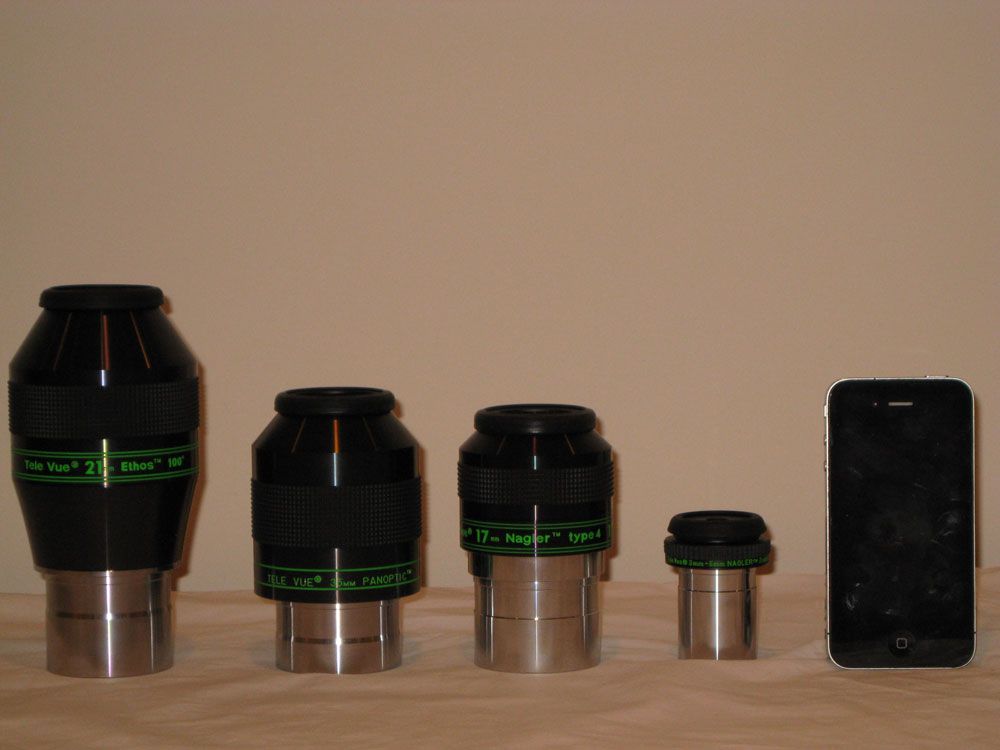
From Left to right: The 21mm Ethos, 35mm Panoptic, 17mm Nagler Type 4, 3-6mm Nagler Zoom and an iPhone 4
First Impression
I own some large 2” eyepieces including the 17mm Nagler type-4 and the 35mm Panoptic (the wide field eyepiece I take abroad with my APM TMB 105 refractor) but the 21mm Ethos is another league altogether when it comes to size and weight. Unless you happened to use the Nagler 20mm Type-2 from many years ago (weighing 1.05kg), it is unlikely you have ever come across a commercially made eyepiece that is as heavy as this one. It truly dwarfs all other EPs in your case, even the venerable Nagler 31mm Type-5 at 0.99kg (though the 31mm is fatter), the previous heavy weight champ, is a touch lighter. The initial impression is exactly what I have come to expect from a Tele Vue eyepiece, excellent build quality throughout with some thoughtful touches. There is a bevelled undercut on the chrome barrel as a safety feature to prevent the EP slipping out of the focuser which considering the weight is a real risk and the rubberised grip keeps it safe even in glove wearing hands. For those that wear glasses, the Ethos uses the standard, soft fold-down eye guard seen on many other Televue eyepieces including the 35mm Panoptic. The coatings look exceptional and have a dark green/violet tint to them when viewed at an angle. I would suggest that the coatings appear a touch darker than those on older Tele Vue eyepieces like my Nagler 17mm Type 4 indicating better light throughput. The base of the eyepiece is threaded to accept 2” filters.
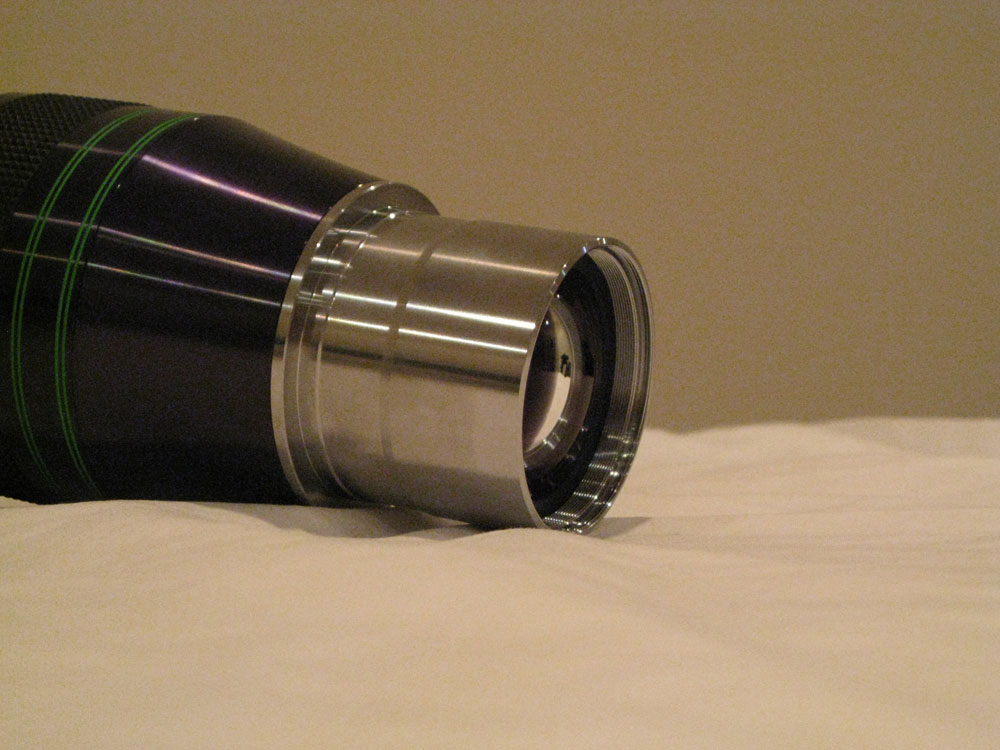
Base view of the 21mm Ethos showing threading for 2″ eyepieces. Note that rear lens element is very close to the end so caution is advised when screwing in filters
First Light
My first use of the Ethos 21mm came at the September 2013 Astrocamp in the Brecon Beacons where I paired it with my APM LZOS 180mm f/7 triplet Super-Apo (delivering a 1.6o field and 60x). That scope has virtually perfect optics so any visually observed defects were likely to be generated in the eyepiece. As dark descended on the observing field I rebalanced the scope to the introduction of the 21mm Ethos, its bulk having thrown off the balance from the sizeable Nagler 17mm Type 4 I had concluded the previous nights observing with. My first target was one of the true showpiece objects found anywhere in the heavens, the Double Cluster in Perseus, an object that I have viewed hundreds of times through numerous scopes. I did not like that first viewing experience at all. Unable to fully take in the entire field in one go, feeling some detail was being lost to my peripheral vision, I found myself struggling and trying in vain to take in the field in one go, adjusting my observing position relative to the eye lens, to make myself aware of the field stop that is somewhat obvious even in 82 degree eyepieces. My thoughts immediately flashed to the £600 plus cost. Not quite ready to give up just yet, I tried a few more open clusters located in Cassiopeia but I was being left with the same feeling of straining to see it all in one go.
However, I persevered through those first couple of hours and then I realised something startling. I had relaxed, accepted that I would not take in the field in one go, allowing myself to become completely immersed in the view, and the eyepiece and the telescope just melted away and started delivering some of the best observing I have ever experienced. With the Ethos you are able to actually look around the view, much as one does with the unaided eye and the experience is truly spectacular.
I returned to the Double Cluster with my new relaxed viewing style and was left speechless. With a 7” triplet on the observing field there is usually a queue of astronomers eager to have a peak. The superlatives (and even more colourful language!) being uttered by observer after observer about that view of the Double Cluster confirmed that this is a very special eyepiece indeed. The Double Cluster was also a very useful test for field flatness and edge of field of performance. I noticed no peripheral field aberrations at all and stars were sharp even as they crossed the field stop.
When tiredness finally set in and I decided to call it a night, I realised I was still using the 21mm Ethos and had not changed the eyepiece once during the entire 7 hour observing session. A 1.6o field and 60x magnification with my APM LZOS 180mm triplet Apo had provided me with an unforgettable nights stargazing. To put that in context, the field is only 0.2o less than my Panoptic 35mm but it delivers almost twice the magnification. At times I felt like I was looking at very familiar objects but for the very first time, such was the transformation afforded by the higher magnification, darker sky background and wider field of the Ethos.
Continued Use
I was anxious to try out the Ethos with my Celstron Nexstar 11, not because the f/10 light cone would put any pressure on the eyepiece, but with an almost 3 metre focal length, I am always looking for an eyepiece that can show me more sky with the SCT. My wide-field travel eyepiece, the Televue 35mm Panoptic marries a good compromise of wide field views without too much weight and bulk. In the SCT it will give a 0.79 degree field at 80x magnification. Using the Ethos 21mm, you sacrifice only 0.05 degree of actual field but the magnification increases to 133x. It is difficult to convey in words but this new perspective makes even the most familiar of objects seem new. M42, the Great Orion Nebula was my first telescopic Messier object with a 4.5” Newtonian I purchased with money from a Christmas job and having viewed it countless times since, I would like to think I am as familiar with its appearance in the eyepiece as anything in my life, yet with the Ethos 21mm it was a whole new experience. Viewing almost 45 arcminutes of sky at over 130x is extraordinary, the twists and tendrils of glowing nebulosity that cradle the Trapezium seemed to standout as never before, benefitting from the darkening of the sky background and improved contrast and visible detail. And the same experience was repeated with other larger DSOs such as M31.
Pairing the Ethos with my two 4” class refractors, the APM TMB 105/650 and the TMB 115/805 was also an incredible match. In the 105, the Ethos produces a 3.2o field at 31x. That is high powered binocular territory (a typical 20×70 binocular will have a 3-4 degree field) but with far more light grasp and 50% more magnification. Scanning the clouds of the Milky Way is joy with this eyepiece. The superb correction and flat field all the way to edge just allows you to fall into the view.
After using this eyepiece for quite some time I have noticed that the colour rendition is perhaps a touch cooler than some other eyepieces in the Televe line-up though this has an advantage that it can make the dimmest objects easier to see but I would stress the colour rendition is still very natural. I only noticed this slightly cooler appearance when switching between my Type 4 and 6 Naglers and the Ethos on the same object.
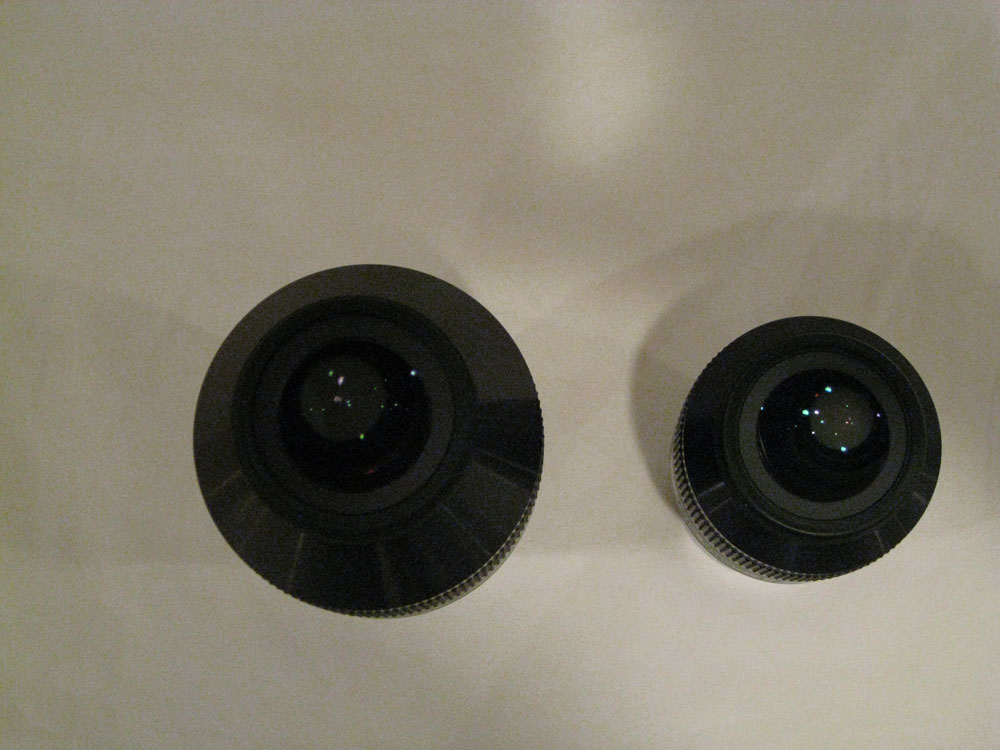
Eye lens view of the 21mm Ethos (Left) and 17mm Nagler Type 4 (Right). Note the slightly darker coatings on the Ethos
The moon and planetary performance
I am not one for lunar observation. I have always thought of the moon that bright light in the sky that prevents me from hunting my quarry, deep sky objects but when you can take in the entire surface at 133x with plenty of room to spare, as it is with my C11, I decided to take a look. While 133x is not a particularly high power, especially for lunar observation, it certainly offers a pleasing level of detail. To observe any particular lunar feature of interest you just adjust your gaze and not the telescopes’ pointing. I can only imagine that the shorter focal length Ethos must give the impression of being in lunar orbit. While under the stern test of a bright moon I checked for any evidence of internal reflections but saw none, indicating an excellent level of internal baffling.
I tend to use my refractors on un-driven mounts and the extra field afforded by the Ethos which is sharp all the way to the edge allowed me to spend more time viewing and less time nudging the telescope to keep my planetary target in view. One might imagine that all those air to glass surfaces inside the Ethos would rob the view of absolute sharpness but I can think of very few eyepieces that can match the Ethos in this department, save perhaps Televue’s own Delos range and the TMB Supermonocentrics which ever so slightly edge it, but it is safe to say that the Ethos is up there with best in planetary eyepieces.
The Majesty Factor
Sounds a bit like marketing spin, “the Majesty Factor.” An essay written by Al Nagler not long after the launch of the Ethos speaks of the “Nexus of Contrast, Power and Field.” In this essay Al Nagler looks to extend a more general conclusion of a similar article written for Sky & Telescope in 1991. “For DSO viewing, choose the highest power that frames the subject, so long as the sky background does not reach black, and the atmosphere does not degrade the resolution. The smaller exit pupils permit a darker sky background which achieves greater contrast against the fixed brightness of stars, while the greater magnification reveals more structural details on extended objects – Eyepieces with larger apparent fields maximises the viewing experience.” The result is what Al would call the Majesty Factor, the nexus of contrast, power and field.
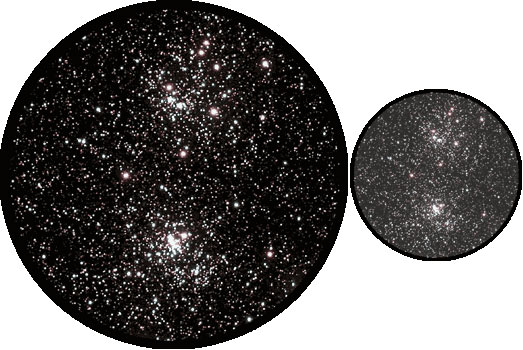
Illustrative comparison of the view of the Double Cluster through the 13mm Ethos and 26mm Plossl with the same 0.9 degree field. Source: Televue.com. TV-60is image of Double Cluster by Robert Reeves
In practice what does that actually mean, and how might one quantify it? Consider the range of apparent fields on offer over the different ranges of Televue eyepieces, the Plossl at 50o, the Panoptic at 68o, the 72o Delos, the 82o Nagler and the 100o Ethos. The Double Cluster spans 60 arcminutes and would be framed by a 26mm 50o Plossl eyepiece in my 180mm f/7 refractor with an exit pupil of 3.8mm. Now to provide context for the step up provided by the Ethos we can assign an arbitrary rating of 1 to the magnification and 1 to the contrast of the view with this eyepiece. Therefore, for the given true field, the Majesty Factor = 1 (power factor) x 1 (contrast factor) = 1. Now let’s switch to the 13mm Ethos which yields the same true field of 1.0o but at twice the power and half the exit pupil (1.9mm). The 1.9mm exit pupil is only 25% of the area of 3.8mm exit pupil of the Plossl, so the sky background darkens by a factor of 4 and the magnification yields twice the detail. Using the same formula as before, 2 (power) x 4 (contrast) = 8x majesty factor of the 50 degree Plossl. This might seem a bit of marketing hyperbole but I think it is an interesting attempt to explain just what is happening when one views through an Ethos compared to eyepieces with narrow apparent fields of view. The accompanying diagram helps to demonstrate this same concept visually.
Conclusion
The 21mm Ethos is stunning eyepiece. The experience of true immersion in the view has to be experienced to be believed, and it delivers this with a flat field, sharpness to the edge, no astigmatism and no internal reflections. The advantage of the extra field for those of us who like to use un-driven Alt-Az mounts is fantastic and in long focal length telescopes like my 11” SCT, you are no longer restricted to lower powers to achieve those wider fields of view.
I recently spoke with a friend who has built a spectacular 16” f/3.5 Dobsonian. He craves a wide-field so he can take in the whole of the Pleiades in one view, but the f/3.5 focal ratio means that many long focal length eyepieces will produce an unusable exit pupil (calculated by dividing the focal length of the EP by the telescope focal ratio) of well above 7mm which is about the maximum pupil dilation, as well as possibly revealing the shadow of the secondary mirror. The 35mm Panoptic for example will produce a 1.6o field at 41x but with a 10mm exit pupil. Up steps the 21mm Ethos. The field would be 1.5o at 68x with a 6mm exit pupil. It is not quite there for the full extent of M45, but only just misses and it is a usable exit pupil and magnification. It strikes me that the 21mm Ethos is the eyepiece for the modern astronomy world where large aperture Dobsonian telescopes with very fast optics are becoming the norm but their very nature restricts the users to shorter focal length eyepieces, and hence narrower fields of view. He is anxious to borrow mine. I suspect he might not want to give it back.
The 21mm Ethos is truly the crown jewel in the wide-field eyepiece universe delivering an experience beyond any other wide-field design I have used but it is very heavy which can cause some balance issues, and then there is the small matter of the cost. At approximately £600, the price of entry into the true space walk experience is high, dwarfing what many would spend on an entire telescope, but I believe that price is compensated for by the incredible performance. Televue have once again raised the bar in the wide-field stakes. All hail your Majesty, the Ethos 21mm.






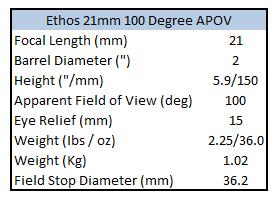
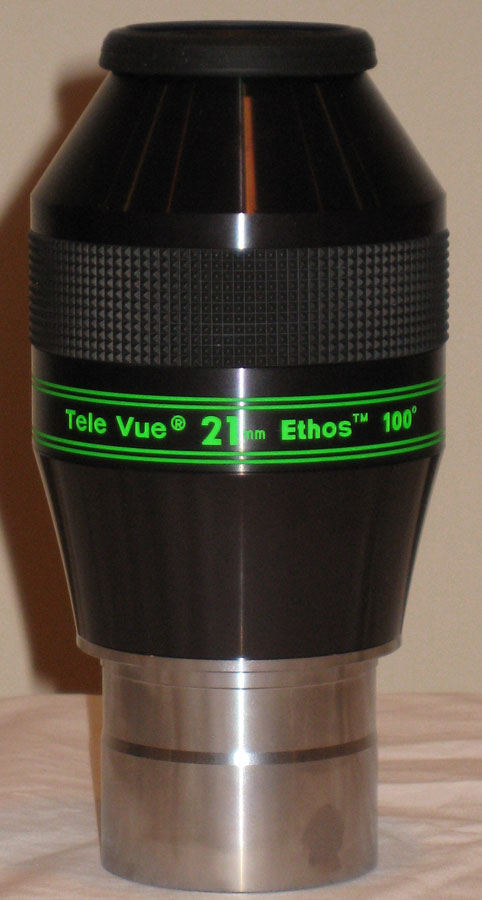
I am thinking of filling a gap in my eyepiece collection with a 17mm wide field Televue.Either of Ethos,Nagler or Delos.Cannot imaging a 100 degree fied.I have a Celestron C8 SCT and C100 ed f9.Your review is very sweet,like music to an amateur like me.It is a great read indeed.I am visiting The Wide Screen astronomy shop in London soon.They have said that they will put these eyepieces in a telescope for me to try.I am almost convience to go for the Ethos.
Thanks,
Martin
Interesting reading as I have an 11 inch SCT f10 , will be discussing with Simon at Widescreen as I am keen to get the best out of my telescope.
Pingback: Review of the Tele Vue Delos Eyepiece Range | Alpha Lyrae
Thanks for the review, Matthew. I have been hovering over the “buy” button on one of these for a while and your description of its performance in the 11″ SCT and other scopes has persuaded me to go for it. Now I need to challenge myself on whether or not I can justify keeping my beloved 31mm Nagler! 🙂
Having had one now for 6 months, all I can say is its all true! When you can see the likes of Jupiter in the context of distant stars, its a whole new ball game, like being in some sort of film, except this is real, how it is right now.
Tele Vue really created something special with the 21mm Ethos. I have had some stunning views using the 21mm through a variety of scopes since I wrote this review. It never fails to impress.